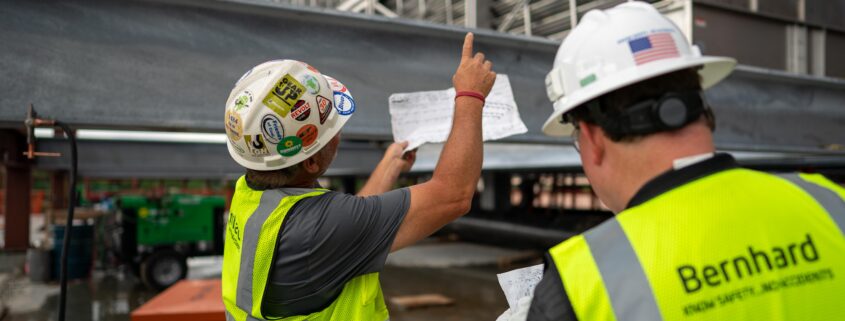Monitoring-Based Commissioning takes the “Maybe” out of Energy Efficiency
At Bernhard, we believe knowing for sure is much better than relying on a “best guess.” When it comes to dealing with a large campus of interconnected buildings that may have been constructed at different points — and to radically different specs — over decades, going from “best guess” to absolute certainty about energy use, efficiency, and infrastructure reliability can be a frustrating puzzle.
Solving the puzzle of energy efficiency takes dedication and a commitment to staying ahead of the curve and today’s best monitoring technology and data analytics. That’s where Bernhard’s Operations & Maintenance (O&M) Training, Monitoring-Based Commissioning (MBCx), and the Bernhard Connect® platform can go to work for you.
O&M Training
Bernhard’s O&M Training starts with a deep look at the energy and infrastructure challenges faced by your facilities, followed by an assessment of each O&M member’s overall proficiency. We then make the most of instructional time by targeting specific areas where extra attention and improvement are needed by targeting specific areas where extra attention is needed.
From there, seasoned instructors use active learning techniques to engage and empower O&M staff, helping them take charge of energy efficiency and infrastructure resilience. In the process, staff gain a much deeper understanding of technical concepts and terms, building systems, equipment, and operations, troubleshooting and diagnostics, analytics and optimization, real-world case studies, and more.
Our goal is to shape your facility’s O&M workforce into a cohesive, purpose-driven team that’s always working to achieve greater energy efficiency, and which can spot trouble before it can metastasize into a real threat to mission-critical services.
Monitoring-Based Commissioning (MBCx) and Bernhard Connect®
Keeping critical systems running at optimal efficiency at all times is the key to realizing significant energy savings and reliability for large facilities. It can also be complex. To succeed, a team has to keep an eye on potentially hundreds of key performance indicators (KPIs) at once, closely monitoring complicated systems that may be scattered over a sizable campus. Simultaneously, they must also find time to look out for, recognize, and act on the often-subtle warning signs that could indicate a major problem is brewing.
Flying blind on analytics and monitoring is a big part of why many large facilities see their energy usage and costs spiral up year after year. But, as the old saying goes, information is power. With MBCx, operators can find the archival data, automated fault detection, remote management, and real-time system information they need to find efficiencies, protect mission-critical systems and improve employee productivity.
Bernhard’s new and existing building MBCx program focuses on realizing long-term, sustainable savings, and operational resilience. Our team of professionals includes engineers, data analysts, and designers who know energy and infrastructure through boots on- the-ground experience. Our MBCx team delivers clear insights and recommendations so that you can make data-driven decisions. Bernhard is ready to put that knowledge to work for you.
Our MBCx program leverages Bernhard Connect®, Bernhard’s cloud-based energy platform. Built around ease of use, agility, and automation, with custom dashboards that can be tailored to prioritize areas of greatest concern, Bernhard Connect® provides next-generation control and monitoring to help find the right solution to your facility’s energy challenges, all with better environmental compliance.
Together with customized, hands-on O&M training, these tools focus your efficiency efforts, to help your facility reach significant energy savings faster and sustain or increase those savings over the long haul.
Real-world success stories
Read on for examples of where Bernhard’s O&M training and MBCx projects made a big difference for our customers.
UNIVERSITY OF ARKANSAS FOR MEDICAL SCIENCES (UAMS)
In July 2019, the University of Arkansas for Medical Sciences (UAMS) was given approval by the University of Arkansas System for a $150 million Energy Savings Performance Contract (ESPC) to be implemented by Bernhard. Covering significant upgrades, retrofitting, and the installation of campus-wide metering for 5.2 million square feet of healthcare space, the project is the largest energy savings project in Arkansas history and one of the largest projects of its kind in the United States. Together, these efforts will save UAMS over $4.8 million per year in energy costs.
As part of the project, Bernhard began offering training to UAMS O&M staff in 2020. Since then, we’ve completed several customized training sessions, including classes covering UAMS’ new $50-million energy plant, which was constructed as part of the project. Opened in October 2021, the new East Central Energy Plant can provide 100 percent of backup power needs for the UAMS campus on-demand.
Bernhard’s O&M training around the new power plant ran the gamut, covering its systems in-depth. Instructors discussed how the plant functioned, troubleshooting, and red flags to look out for, including with the plant’s Diesel Exhaust Fluid (DEF) system. UAMS’ previously-existing West Central Energy Plant doesn’t have a DEF system, so our experts knew it needed to be a focus during O&M training.
Less than a week after the session covering the DEF system, Bernhard received an email of thanks from Chris Gray, UAMS Assistant Director of Engineering and Operations.
Gray said that a few days after the training session, a contractor dug into an electrical line, interrupting power for a portion of the campus. That caused East Central Energy Plant generators to automatically start. While they were running, air pressure for the DEF system dropped below the designated set point on two of the generators. The units automatically shut down as designed, Gray said, but thanks to the thorough training provided by Bernhard, electrical crew members were able to identify the alarms the generators were giving, quickly relay that information to a supervisor and keep backup power available.
“Several members of our electrical team informed me later that without that training, they probably would not have known why the units alarmed and shut down,” Gray wrote.
In a true energy emergency, that’s the kind of confusion that could have endangered critical services — and a $50 million infrastructure investment. Thanks to Bernhard’s commitment to deep, personalized O&M training, the staff at UAMS understood what was happening and could react appropriately.
BANNER HEALTH
Back in 2010, Phoenix-based Banner Health System identified significant energy-saving opportunities through retro-commissioning projects. With more than 30 hospitals spread across eight states, Banner had taken steps to make many of their older buildings more energy efficient. But within five years, performance drift sapped most of the gains.
Finding a strategy that could both realize and sustain energy savings long-term was hampered by the same forces facing a lot of large, campus-based facilities: an array of conflicting automation technologies, maintenance protocols, and computerized maintenance management systems adopted over the life of the system.
To help solve the issue, Bernhard (then ETC Group) stepped up to deliver an innovative pilot program at Banner Health’s Thunderbird Medical Center, built around a centralized operations center and monitoring-based commissioning (MBCx). Relying on real-time data delivered to a monitoring hub staffed by a small team of technicians and analysts, this system could collect, store and analyze information from buildings across the Thunderbird Medical Center campus. Using automated fault detection and alerts, the system soon began identifying opportunities to optimize efficiency.
The MBCx pilot program at Banner Health Thunderbird was a huge win for the health system, delivering energy savings of $449,000 per year for that campus, saving 4.7 million kilowatt hours of electricity. Seeing the promise of the approach, Banner Health expanded those efforts system-wide in 2015. As before, the strategy quickly made headway at lowering Banner Health’s energy costs and reducing mission-critical failures.
Since 2016, an MBCx system backboned on the Bernhard Connect® platform has slashed Banner Health’s overall annual energy costs by almost $12 million per year. Relying on a centralized monitoring staff of less than 15, Banner Health has had a near-perfect track record for more than five years now, lowering energy use every quarter. Meanwhile, automated monitoring for faults and anomalies saves Banner Health an additional $3.8 million per year that would have been lost to performance drift, all while reducing hot and cold calls, deferred maintenance, and equipment repair times.
Thanks to MBCx, Banner Health analysts are even able to predict problems before they become a trouble. For example, like many hospitals, Banner Health facilities sometimes experienced chiller surging, a condition in HVAC systems in which refrigerant backflows from the condenser to the compressor. Unchecked, chiller surging can lead to serious system damage, jeopardizing mission-critical services.
Through consultation with engineers to understand the warning signs of chiller surge and how it appears in the data stream, the team at Banner is now able to accurately predict chiller surge remotely before it happens, allowing technicians to switch to backup systems to ensure zero interruption to operations or patient care.
Thanks in part to these efforts, the American Society for Health Care Engineering awarded Banner Health their 2021 Excellence in Health Care Facility Management Award, which showcases innovative facilities management programs that improve patient care.
MIDLAND HEALTH
Beginning in December 2020, Midland Health and Bernhard launched a 15-year energy asset concession arrangement. It was the latest chapter of what was then a 10-year working relationship between Bernhard and the Texas-based health system.
Over the course of the project, Bernhard and Midland have worked together to pare down the system’s heavy backlog of needed capital improvements, including upgrades to the central energy plant’s chilled water and tower water system, heating water system, steam system, and air-handling units. Bernhard also implemented system-wide retro-commissioning, lighting, and building automation upgrades. Together, these improvements to Midland Health facilities will generate a minimum of $464,717 in annual utility cost savings, guaranteed by Bernhard.
To help maximize and sustain efficiency and keep performance drift at bay, Bernhard implemented a MBCx program that leverages the power of the Bernhard Connect® platform.
In just one example of how MBCx is paying off for Midland Health, earlier this year, Connect-based analysis was able to find and help solve a previously-undiagnosed fault in a Heat Pump Chiller Heater (HPCH) that was causing the system to run inefficiently and missing set performance goals for heat production.
A very complex machine that requires careful attention to detail when being set up to produce heat, an HPCH also requires other components of its family system to be modified for optimal performance. Working with reps from Carrier and Midland’s Plant Ops teams while analyzing MBCx-delivered data, it was discovered that the maximum, as-designed heating temperature and capacity of the HPCH could not be achieved. It was having a real impact on energy efficiency.
Without MBCx and the power of data-driven analytics, it could take even skilled team days or weeks to chase down the problems in a system as complicated as an HPCH and the constellation of associated systems in which it works. By using multiple teams of Bernhard experts including Bernhard Connect®, MBCx, Logic BAS Controls Design, Programming, Cx, Asset Management Operations, and the Engineering Project Executive, Bernhard was able to cross-reference legacy data to decisively isolate a number of factors that were contributing to the issue, including a refrigerant leak that was causing one compressor to run at sub-optimal efficiency, throwing the efficiency of the whole system off.
Working with Bernhard and Carrier, teams at Midland have been able to correct many of the issues with the HPCH, including significant improvement to the compressor issue that was at the heart of the problem. Using real-time data to prioritize repairs and steer their work, the team’s incremental, MBCx-guided efforts have added up to more efficiency, greater system reliability, and big savings. That’s especially important at a time when gas rates have topped $12 per MMBtu in recent months.
Ready to see how O&M Training, MBCx, and Bernhard Connect® can take a bite out of your facility’s annual energy costs while optimizing system performance and reliability? With more than 100 years of experience servicing higher education, health care, commercial, and specialty clients, Bernhard has the know-how to make it happen. For more information, visit Bernhard.com.



